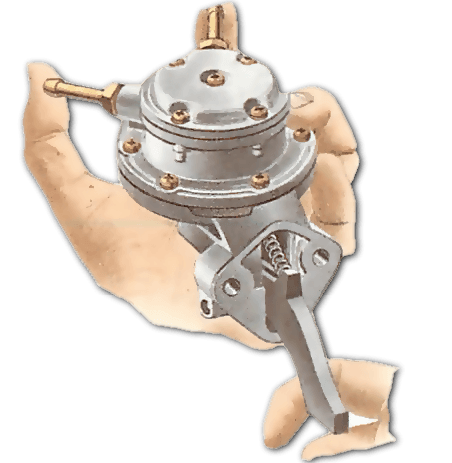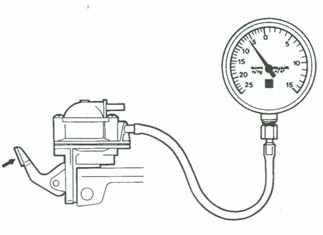You’re standing in your garage, staring at your car, wondering why it won’t start. You’ve checked the battery, the spark plugs, and the ignition.
Could the culprit be the mechanical fuel pump? If you’re nodding your head, you’re in the right place. Testing a mechanical fuel pump might sound daunting, but it’s simpler than you think. You don’t need to be a seasoned mechanic to get your hands dirty and diagnose the issue.
In this guide, you’ll discover the step-by-step process to test a mechanical fuel pump effectively. Imagine the satisfaction of solving the puzzle yourself, the thrill of knowing you’ve saved time and money. Let’s dive in and make sure your car gets the fuel it needs to roar back to life.
Tools And Equipment Needed
Testing a mechanical fuel pumpneeds some tools. A fuel pressure gaugeis first. It measures the pump’s pressure. You also need a wrenchto loosen bolts. A screwdriverhelps with small screws. A containercatches spilled fuel. Safety goggles protect your eyes.
A ragcleans any mess. Gloves keep your hands safe. An owner’s manual provides guidance. A multimeterchecks electrical connections. These tools make testing easy.
Identifying Symptoms Of A Faulty Fuel Pump
A car may struggle to startif the fuel pump is bad. The engine might stallor die unexpectedly. Listen for a whining noisefrom the fuel tank. This could mean trouble. The car might sputterwhile driving at high speed. Fuel pumps also cause loss of powerwhen climbing hills. A faulty pump can lead to poor fuel efficiency. Watch for these signs.
Another symptom is the car jerkingduring acceleration. It may feel like it’s running out of gas. Keep an eye on the fuel gauge. If you notice rapid drops, it might be the pump. The car could also have difficulty maintaining speed. All these are signs of a faulty fuel pump.
Safety Precautions
Always wear safety gogglesto protect your eyes. Protect hands with gloves. Make sure the car is on a flat surface. Turn off the engine before checking. Keep a fire extinguishernearby. Fuel is flammable and can catch fire. Avoid smoking or open flames. Work in a well-ventilated area. Ensure your tools are in good condition. Damaged tools can cause accidents. Double-check all connections. Loose connections can lead to leaks. Leaks can be dangerous.
Locating The Fuel Pump
The fuel pump is usually found near the engine. To locate it, check the engine compartment. Some cars have a plastic cover. Remove it carefully. The pump may be hidden under the cover. Others have it mounted on the side of the engine. Look for a small device with tubes coming out. The tubes carry fuel to the engine.
Older cars may have the pump near the fuel tank. Check the rear of the car. It’s often mounted on the frame. Look for a metallic device with wires. Use a flashlight if it’s dark. Always ensure the car is off. Safety first!
Testing Fuel Pressure
A fuel pressure gaugechecks if the pump is working. Attach the gauge to the fuel line. Turn the key to start the engine. The gauge shows the pressure in the line. Read the numbers on the gauge. If the pressure is too low, the pump might be bad. If the pressure is too high, there may be a blockage.
The pressure reading tells if the pump is healthy. Normal pressure means the pump works fine. Low pressure means fuel is not reaching the engine. High pressure means fuel might be blocked. Check the reading carefully. It helps fix pump problems.
Inspecting Fuel Lines And Connections
Always check the fuel lines first. Look for any cracks or leaks. Damaged lines can cause the pump to fail. Connections should be tight and secure.
Loose connections can lead to fuel leakage. This is dangerous. Use a wrench to tighten them if needed. Corrosion on connections is a bad sign. Replace corroded parts immediately.
Ensure the fuel filter is clean. A clogged filter can block fuel flow. This affects the pump’s performance. Regular checks keep your system working. Safe and efficient.
Listening For Unusual Noises
Start the engine and listen carefully. A healthy fuel pump sounds smooth. Pay attention to any unusual noises. Clicking or whining sounds can be a sign of trouble. Move closer to the pump. Listen for any loud or strange sounds. These may mean the pump is worn out. Turn off the engine and listen again. Sometimes noises stop when the engine is off. This can help you know if the pump is the issue. Ask someone to help if needed. They can start the engine while you listen. This makes it easier to hear any unusual sounds. Regular checks can keep your pump working well.

Credit: www.howacarworks.com
Checking For Fuel Leaks
First, park your car on a flat surface. Turn off the engine and let it cool. Look under the car for any fuel stains. Use a flashlight to check all around. Inspect the fuel pump and lines for any wet spots. If you see any, this could mean a leak. Check the fuel pump gasket and fittings. They should be tight and dry. Loose fittings can cause leaks. Smell around the fuel pump. A strong gasoline smell might mean a leak. Feel the fuel lines with your fingers. Any wetness could mean a problem. Remember to wash your hands after touching fuel.
Testing Fuel Delivery
Gather tools for the fuel test. You need a container and a timer. Disconnect the fuel line from the carburetor. Place the line into the container. Turn on the ignition for about 10 seconds. Measure the fuel collected in the container.
Check the amount of fuel. Ensure it matches the vehicle manual. If the amount is low, there might be a problem. This could mean a bad fuel pump. Too much fuel can also be a problem.
Compare the collected fuel with the required amount. If it matches, your pump is likely working well. If not, inspect the pump for damage. Look for leaks or worn parts. A slow pump might need fixing or replacing. Always check for blockages in the fuel line.

Credit: sucarb.co.uk
Examining The Fuel Pump Diaphragm
The diaphragm is an important part of the fuel pump. It helps move fuel to the engine. Check for any tears or holes. A torn diaphragm can cause problems. Use a flashlight to look closely. Look for wear and damage. Replace the diaphragm if needed. This keeps the pump working well. A clean diaphragm means better fuel flow. Take time to inspect carefully. Ensures safe driving. A small hole can cause big issues.
Replacing A Faulty Fuel Pump
Checking a mechanical fuel pump ensures your vehicle runs smoothly. Start by inspecting connections for leaks or damage. Use a pressure gauge to measure fuel flow, ensuring it meets manufacturer specifications. If results are inconsistent, consider replacing the fuel pump to restore optimal performance.
Steps For Removal
First, make sure the car is turned off. Locate the fuel pumpunder the vehicle. Use a wrench to remove the boltsholding the pump. Be careful with the fuel lines. They might still have fuel. Use a container to catch any spills. Disconnect the electrical wiresconnected to the pump. Keep track of all parts.
Installation Of A New Pump
Place the new pump where the old one was. Secure it with bolts using a wrench. Connect the fuel linescarefully. Make sure they are tight. Attach the electrical wiresto the new pump. Double-check everything. Start the car to test the new pump. Listen for any strange noises.
Maintenance Tips
Regular checks keep fuel pumps working. Always inspect for leaks and cracks. These can cause big problems. Check the pump’s pressure. Low pressure can mean trouble. Use a gauge for this test.
Clean parts often. Dirt can block the pump. This stops it from working well. Use a cleaning clothor brush. Follow the pump’s manual for help.
Listen for strange noises. A good pump runs quietly. If it makes noise, it may need fixing. Always keep an eye on the pump’s condition.

Credit: www.youtube.com
Conclusion
Testing a mechanical fuel pump is crucial for engine health. Follow these steps to ensure proper function. Listen for unusual sounds. Inspect for leaks and damage. Check fuel pressure. These actions help prevent engine issues and maintain performance. Regular checks can save you time and money.
Keep your vehicle running smoothly. A well-maintained fuel pump ensures efficient fuel delivery. This leads to better performance and reliability. Always prioritize safety during inspections. Take action promptly if you find problems. Your vehicle will thank you with dependable service.
Keep this guide handy for future reference.
